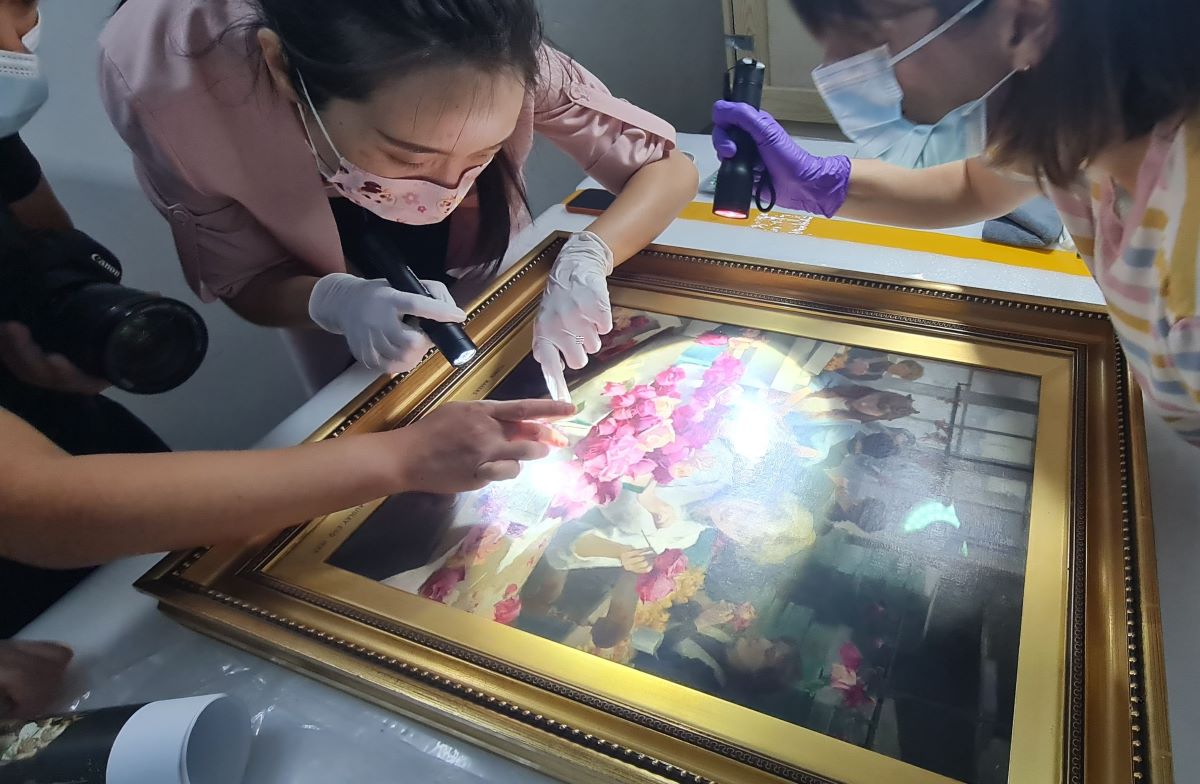
Checking condition of artwork at Anhui Museum
Photo: Nicola Farrrington
Regenerating post-pandemic partnerships with China
It’s more than a year since China reopened its borders following the pandemic with the promise of reviving its international arts scene. Alex Lalak explores what this means for UK arts organisations looking to re-forge their links.
Four years ago, the cultural scene in China changed almost overnight when the sudden impact of the global pandemic put a freeze on one of the world’s most vibrant art markets. Exhibitions and tours were put on hold, venues were closed, over 4,000 performances were cancelled between mid-February and mid-March 2020, and 80% of arts programmes across the country were suspended or postponed.*
Fast forward a couple of years, and everything had changed.
While China’s economy was still in recovery, like most countries across the globe, the nation’s appetite for cultural experiences had clearly begun to bounce back by 2022. Sales of 173,000 ticketed performances generated box office revenue equivalent of £1bn and live streaming of arts projects attracted more than one billion viewers.
Access to Asian audiences without the need for travel
But the true extent of the regeneration of China’s art scene became clear when it reopened its doors to global visitors and programming in January 2023. One of the first, and most significant, international art tours was the spectacular Botticelli to Van Gogh: Masterpieces from the National Gallery, which opened at the Shanghai Museum. When 40,000 early bird tickets went on sale, they sold out in 48 hours.
“This tour was an exceptional opportunity to bring even more people and paintings together globally by offering a chance for Asian audiences to access our collection without having to travel to London,” said the National Gallery’s Senior Touring Exhibitions Manager Hannah Hawksworth.
This historic exhibition was made possible by temporary building works at the gallery in London, which created the opportunity to put together what Hawksworth describes as “a National Gallery in miniature”, featuring 52 masterpieces from the collection including Raphael, Titian, Caravaggio, Rembrandt, Constable, Monet and Van Gogh – a rare touring collection of the gallery’s greatest treasures.
Challenges of the pandemic have been overcome
Shanghai was the first stop on the tour, and the timing made it an ambitious project on many levels.
“We started the tour when there were still Covid restrictions in Shanghai, so it was logistically challenging,” says Hawksworth. “But the team were very dynamic, and we were able to respond as the restrictions lifted. Both museum teams are very experienced, and it has been a very collegiate and positive experience for us.”
The exhibition, now on display at the Hong Kong Palace Museum in the new West Kowloon Cultural District, drew record audiences of 420,000 to the Shanghai Museum over nearly four months, with 85% of the visitors under 50.
It was a wild success by any measure, and clear evidence that the challenges of the pandemic period have been overcome.
 Vistors viewing exhibition at Guangdong Museum. Photo courtesy of Youxiang Art
Vistors viewing exhibition at Guangdong Museum. Photo courtesy of Youxiang Art
Navigating the challenges of cross-cultural projects
Another highlight of last year was the National Museums Liverpool’s touring exhibition Art in the Age of Victoria, a world premiere created specifically for Chinese audiences. It toured to three venues and explored the transformation in fine and decorative arts during a time of an extraordinary change in Britain, the reign of Queen Victoria.
“Collaborations like this tour most definitely foster good will and respect and are a great way for us to learn about different histories and cultures from around the world,” says National Museums Liverpool’s Head of Touring Exhibitions Andrew Bullock. “It really was a wonderful opportunity for Chinese audiences to see a unique exhibition which may never be repeated.”
The tour was a huge success, starting at the Guangdong Museum in April, where it went on to attract 132,000 visitors during its three-month showing. But pulling it off was a challenge for the National Museums Liverpool team, working closely with their partner venues in China with the team having to navigate issues ranging from language barriers to weather conditions.
“Right up until January 2023 we were preparing different scenarios for how we might courier the exhibition including couriering completely virtually or having a combination of physical and virtual couriers,” says Bullock. “Our contact with colleagues at the British Council proved to be very valuable, offering advice and connecting us with individuals and organisations who could potentially offer support.”
International collaboration opportunities
Despite the logistical challenges of touring to China, there is enormous ongoing opportunity across the country to create and present both visual and performing arts to an evidently engaged and enthusiastic audience that is eager to discover British and European culture.
Getting cross-cultural projects off the ground can be difficult, but for artists and organisations looking to explore this further, the British Council’s International Collaboration Grants are the ideal support platform.
This £1 million grant programme is designed specifically for the creation of new cultural collaborations between UK artists, arts professionals, arts organisations and their peers around the world.
Applications are currently open with individual grants valued at between £25,000 and £75,000 for collaborative creative projects forged between UK-based organisations and organisations across a range of countries including mainland China.
As China continues to extend its welcome, these grants promise a new era of cross-cultural collaboration and hint at countless thrilling new projects to come.
Alex Lalak is a writer and journalist specialising in arts and culture.
![]() britishcouncil.cn/en/programmes/arts/china-now
britishcouncil.cn/en/programmes/arts/china-now
![]() @cn_British
@cn_British
*Source: Chinese digital publication The Paper.
This article, sponsored and contributed by the British Council, is part of a series aimed at UK arts organisations and artists with an interest in working in mainland China.
Join the Discussion
You must be logged in to post a comment.